Newsletter No.58

Dear Members:

The month of August is full of events and activities for the Nation and our Alumni as we celebrate the 51st National Day with many excitements.
The Central Committee members are now embarking on the many programs that are in place and everyone is so enthusiastic with their projects of which will be put in action.
In conjunction with the Japan Festival in Malaysia (JFM) 2008, we jointly organized the 5S-Kaizen Seminar at the Wawasan Open University in Penang for the very first time held outside the Klang Valley. The response was very positive with nearly 200 participants. The Consulate General of Japan in Penang, Hideaki Hoshi-san and the University Vice Chancellor, Professor Wong T.M graced the event.
The full board members from PAAM with staff member traveled to the Northern region in supporting the program was a great success. We had a memorable outing as we enjoyed the local delicacies and able to tour around the island and visited many heritage sites in Penang.
The MAFAAS meeting was held with the ABK Penang as we take over as the Chairperson for the next 2 year- term. Many fruitful discussions and sharing of information were held during the meeting as we planned ahead for the next World Convention to be held in Japan. It is our hope that we are able to have a strong delegate to Japan in 2009 to support the bid and host the next World Convention in Kuala Lumpur.
To strengthen the brotherhood and co-operation within the regional Alumni Societies, I took the initiative during my business trip to visit and pay a courtesy call to the AOTS Bangkok office and able to meet the Senior General Manager T.Sadatani-san & General Manager M.Taniguchi-san.
We also have the opportunity to meet up with the chairperson of FOSAAS & President of ABK& AOTS Alumni Association -Thailand -Mrs. Pimpilai, and her team members followed with a dinner meeting. It was very beneficial to learn from their success story as they are the leading Alumni in the region with 42 years long history.
I strongly believe friendship is borderless as through fellowship and sincere interaction we tend to gain more knowledge and learn from those around us. Life is full of challenges and you need to explore and be appreciative.
On this note, I sincerely hope that all members can come forward to share their interest that will benefit the Alumni and the community at large.
Wishing everyone good health and happiness always.
President
CL Yang . PJM
“The Central Committee members are now embarking on the many programs
that are in place and everyone is so enthusiastic with
their projects of which will be put in action.”
– CL Yang
Full day Seminar on Kaizen
“Towards Betterment: 5S & Kaizen” by Sarawak Branch
The Sarawak Branch of Persatuan Alumni AOTS Malaysia successfully organized a full-day seminar on “Towards Betterment – 5S & Kaizen” on 11th July 2008 in one of the hotels in Kuching. 37 participants from various companies in Sarawak attended the Seminar. It was an opportunity for the participants to acquire and enhance their knowledge, and to put them into practice in their respective organizations. The speaker of the seminar was none other than PAAM’s Vice President, Mr. Lim Eng Swee, a very experienced practitioner on those subjects. The participants were very responsive; they look forward to similar seminars in the near future.
 |  Participants listening attentively during the lecture |
 Welcome dinner for Mr. Lim |  Some of the branch committee from Sarawak |
Pre-orientation / briefing
for Hippo Homestay Program on
16 May 2008 @ PAAM office, Damansara Jaya
Persatuan Alumni AOTS Malaysia had successfully organized the pre-orientation for Hippo Homestay Program which was conducted by Ms. Sharon Lim. The briefing was divided into 4 important topics parts:
1. Planning BEFORE trip
2. What to do DURING the homestay
3. What to do BEFORE LEAVING Japan
4. POST-RETURN activities


Participants are fully equipped with the handout and info. before depart to Japan
Hippo Homestay Program
8 days in Kyoto, Japan (24th – 31st May 2008)
By: En. Hakim


Despite having the experience of staying in Japan for more than a year during my younger days while doing skill-training, the recent Hippo Homestay Program that I participated is the trip that I cherish more. For a week I was warmly accepted as another member of the Sawami family, a young couple with 3 beautiful children.
14 Malaysian participants spent the six flying hours anxiously thinking of what to expect spending a week in the home of total strangers. To our surprise the moment we stepped into the Hippo Head Office in Osaka, we were welcomed by the foster families, with Malaysian traditional songs and dances. The atmosphere was like a homecoming of family members who had been away for a very long time. Thereafter, we were whisked away to our home and family and spent a wonderful and unforgettable week in Japan.


The one hour train ride to Kyoto allowed me to give a quick introduction of myself to Mrs. Sawami and her pretty five years old daughter, Nina. The Sawami family owns a modern and comfortable double storey house within a quiet and peaceful housing area just outside of Kyoto. I was introduced to Mr. Sawami and two other wonderful children, Ryo and Karin. From then on, my stay in Japan was nicely programmed with sightseeing, shopping, picnic, party, tea ceremony and calligraphy with other Hippo family members in Kyoto. I needed little time to adjust and getting used to my new lifestyle. I enjoyed every minute of it. The only small problem that I faced was to wake up at 3:30 in the morning to perform the ‘Subuh” prayer. I was tiptoeing to the bathroom to clean myself and trying my best not to disturb my host from their deserved rest.
The food was not a problem and every time I craze for the taste of chili I took out my spicy ‘rendang’. Unfortunately, my foster family was not able to enjoy the hot and spicy rendang, kuah satey and ketupat nasi that I had brought along with me.
I visited almost all the famous historical sites in Kyoto including the Ancient Imperial Palace and it was a wonderful experience of getting the feeling of the environment where the Emperor once lived. A day tour to Osaka to visit the giant aquarium was very satisfying as I love rearing fish myself.

There were many memorable moments when I attended the Hippo Family meetings in Kyoto. Those young mothers were learning 19 foreign languages and culture in a rather comical but effective method which they simply explained as ‘no-class room’, ‘no-teacher and no-exam’. How can anyone learn a foreign language without those basic requirements? They are learning them by mimicking what they hear from the CD and correcting their errors among themselves and sharing experiences by those who had made a trip earlier. My short stay was an opportunity to them to hear how the language is actually spoken by a native. I did what I could to correct their pronunciation. It was very satisfying that I managed to make them to call me “Abang” perfectly.
One week clicks so fast, but all good things must come to an end. On the final morning the 14 of us gathered again in Osaka for the bus ride to Kansai Airport. From the sad faces, red eyes and tear drops of the participants, I believe that I was not the only one who was having a great and enjoyable stay but everyone did and I am sure they have their own stories to share. We did not bade ‘sayonara’ nor ‘goodbye’ instead we said “we will see you again…. soon “.
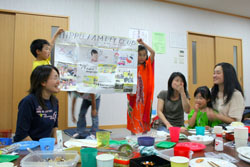
I wish to take this opportunity to thank the wonderful Sawami family members for making my stay so meaningful and make me believe that now I do have a family in Japan. I better stop writing here before I start crying again.
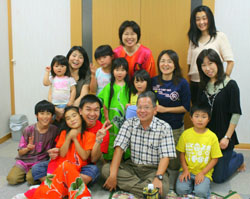 Kyoto Hippo family members | 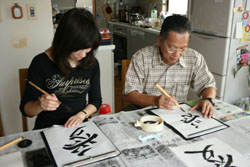 My first lesson in calligraphy |
| At KLIA | |
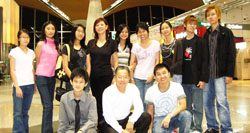 12 of 14 participants, the other two were already in transit from Penang on 23rd May 2008 |  Making sure nothing left behind just before checking-in |
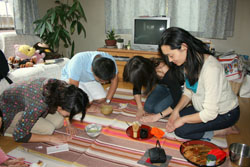 Taking photos before enjoying their short homestay in Japan. | |
| Osaka | |
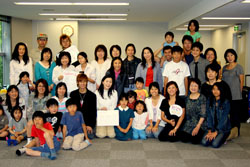 Group photo: Welcome ceremony at Osaka, Japan on 24th May 08 |  “Tea ceremony” demonstrated by a Hippo member |
By: Yap Choon Ming
(continued from issue 57)
METHODS OF INFECTION
A floppy disk or other removable media remains a common source of infection, especially one given to you by a friend or co-worker. The person may not realize that it contains a virus, and you can’t be sure it has been effectively virus-checked.
Opening an e-mail attachment could cause infection, although reading a plain text e-mail won’t. You can never be sure what the attachment is. It might look like it’s a .jpg file, or a harmless picture, but you never know
Downloading software can mean downloading a virus. If you go to a reputable site like Download (www.download.com) and download a well-known program, you’re unlikely to get a virus. But if someone sends you an e-mail with a new program attached, don’t open it!
Office networks can spread viruses. Worms can operate over a network and work their way around several PCs.
HOW TO AVOID VIRUSES
Eject floppies from your disk drive before you start your PC. If the floppy has a boot-sector virus, it will infect your hard disk as soon as the PC starts. Since a boot-sector virus mimics your real boot code, it will try to start up from the floppy. The virus copies itself to your hard drive and gets to work. You can be infected whether the attempt to boot from the floppy was successful, or not.
If you are opening an unknown Microsoft Word file, open it with another related program, such as WordPad. This is because Word macro viruses can only infect copies of files in Word, and WordPad cannot run macros.
Set antivirus software to automatically scan all floppies you use, even new ones. Write-protect any floppies you give to others to prevent them passing on viruses inadvertently when they return them. Hold the floppy face down, with the metal cover toward you. Slide the tab on the upper left corner up to uncover the hole and write-protect the disk.
Use Virus-Protection software to safeguard your PC. An effective program has two components: disinfection and scanning. First, it finds viruses on your hard drive and destroys them, then runs in the background, scanning for viruses as you open and closes files, insert floppy disks, or surf the Net. Download updates, called “definitions,” from program manufacturers’ websites, or subscribe to have updated software sent to you on CD-ROM so that you can identify and destroy the latest viruses.
TOP 10 WARNING SIGNS
Think you’ve got a virus? Not all these symptoms will appear, and some will conceal themselves or may be caused by other reasons. But they will provide a solid starting point for your diagnosis.
1. Your PC runs very slowly for no apparent reason.
2. Programs take long to load.
3. Files disappear from your hard drive.
4. Program files expand in size.
5. You have trouble opening or saving Word documents.
6. Your PC often crashes or suddenly reboots itself.
7. Your hard drive is accessed more often.
8. Your screen colors change, or strange messages appear, such as “Your computer is now stoned.”
9. Devices that once worked now don’t even though you haven’t changed your system configuration.
10. If you are on a network, you notice that the problems affecting your computer have started occurring on other PCs in your office.
Source of the above article: unknown internet website
Practical Japanese Conversation Elementary
– Dai 2 ka –
| Reibun | Example Sentences |
| 1. Kore wa jisho deska? Hai, so des. | 1. Is this a dictionary? Yes, it is. |
| 2. Sore wa enpitsu deska? Iie, so dewa arimasen. Boru pen des. | 2. Is that a pencil? No, it is not. It is a ball point pen. |
| 3. Sore wa nan des ka? Kore wa raita des. | 3. What is that? This is a lighter. |
| 4. Sore wa borupen des ka l. Syapu penshiru des ka? Syapu penshiru des. | 4. Is that a ball point pen or a propelling pencil? It is a propelling penci |
| 5. Are wa dare no kaban deska? Lee san no kaban des. | 5. Whose bag is that? That is Mr. Lee’s bag. |
| 6. Kono jisho wa anata no deska? Iie, watashi no dewa arimasen. | 6. Is this dictionary yours? No, it is not mine. |
| 7. Kono hon wa dare no deska? Watashi no des. I | 7. Whose book is this? t is mine. |
| Kaiwa | Uketsuke de | At a reception desk |
| Ramli : | 308, onegai shimas. | 308, please. |
| Kimura : | Hai, dozo. Kore wa anata no tegami deska? | Here you are. Is this your letter? |
| Ramli : | Hai, so des. Domo arigato gozaimas. | Yes, it is. Thank you very much. |
| Kimura : | A, chotto matte kudasai. Kono borupen mo anata no deska. | Oh! wait a moment, please. Is this ballpoint pen yours, too? |
| Ramli : | Iie, chigai mas. | No! it isn’t |
Useful terms
| Onegai shimas! | Please. (when asking a favor) |
| Dozo! | Please, here you are (when offering someone something) |
| Aa! Oh! Ah! | (an exclamation used when suddenly remembering or noticing something) |
Note: Try talking to your friends and acquaintances (Japanese and Non Japanese) using what you have just learnt. Succeeding in making yourself understood will give you an incentive to study more.Source: Shin Nihongo Kiso 1 (English Translation) Asian Edition
Practical Japanese Conversation Intermediate
– Dai 26 ka –
| Bunkei | Sentence Patterns |
| 1. Kaze o hitan des. | 1. I’ve caught a cold. |
| 2. Michiga wakaranain des ga! oshiete kudosaimasenka? | 2. I don’t know the way, could you tell me? Please! |
| Rei bun | Example Sentences |
| 1. Nihongo ga jozu des ne! Donokurai benkyo shiton des ka? Senta de 1 kagetsu gurai benkyo shimashita. | 1. Your Japanese is very good. How long did you study it for? I studied at the Center for a month. |
| 2. Kyo wa amari tabemasen ne! do shitan des ka? Onaka ga itain des. | 2. You’re not eating much today, What is the matter? I’ve got a stomach ache. |
| 3. Konban patii ni ikimasenka? Iie, ikimasen. Kanai ga byoki nan des. | 3. Are you going to the party tonight? No, I’m not. My wife is not well. |
| 4. Sentakuki ga ugokanain des ga ! chotto mite kudasai masenka? Wakarimashita. Sugu ikimasu | 4. The washing machine doesn’t work, could you take a look at it? Please! Ok. I’ll come right away. |
| 5. Tokei o kaitan des ga! doko de kattarai des ka? Eki no chikaku no tokeiya ga ii to omoimsu. | 5. I want to buy a clock, where can i get one? The clock shop near the station would be good, i think. |
| Kaiwa | Ryo ni hairu | Conversation Checking in at a hostel |
| Takahashi : | Kochira wa ryo no kanrinin san des. | This is the hotel manager |
| Ramli: | Ramli des. Kyo kara osewa ni narimasu. Dozo yoroshiku onegai shimasu. | My name is Ramli. I’ll be staying here from today. |
Watanabe : Watanabe : | Watanabe des.Kochira koso dozo yoroshiku. Shoduko wa koko des. Yushoku wa 8 jihan made des. | I’m Watanabe. How do you do? The dining hall’s over here. Supper’s served until 8.30am |
| Ramli : | Jikan ni ma ni awanai toki, do shitara ii des ka? | What shall I do if I’m going to be late? |
| Watanabe : | Denwa de renraku shite kudasai. | Give me a call and let me know, please. |
| Ramli : | Hai! | Right. |
| Watanabe : | Oturo wa koko de, sentakuki wa kono tonari des. | The bathroom’s here, and there’s a washing machine next door. |
| Ramli : | Ano, oturo no tsukaikata ga yoku wakaranain des ga | Er, I’m not sure how to use the bath…. |
| Watanabe: | Ja, atode setsumei shimas. Saki ni heya e ikimasho | Ok. I’ll explain later. Let’s go to your room first. |
Useful terms
| Kochira wa (kanchirin-san) des | This is (the manager). (used when introducing someone) |
| Osewa ni narimasu | I hope for your kind assistance. (used to thank someone in advance for their help) |
| Kochira koso | Likewise (in response to “dozo yoroshiku”) |
Note: Try talking to your friends and acquaintances (Japanese and Non Japanese) using what you have just learnt. Succeeding in making yourself understood will give you an incentive to study more.Source: Shin Nihongo Kiso 2 (English Translation) Asian Edition